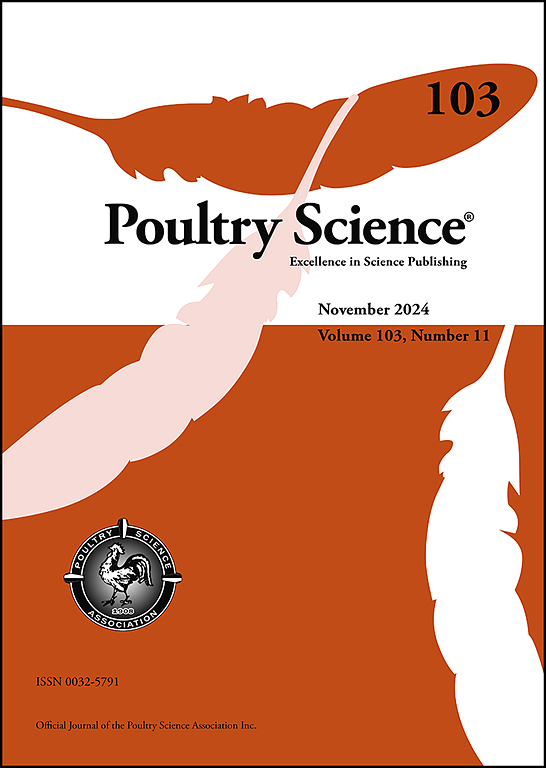The cost of amino acid catabolism for energy utilization in broiler chickens
IF 3.8
1区 农林科学
Q1 AGRICULTURE, DAIRY & ANIMAL SCIENCE
引用次数: 0
Abstract
This review highlights that utilization of dietary amino acids for energy metabolism in broiler chickens imposes a metabolic cost, as their primary role is to support body protein synthesis. This issue becomes more critical in reduced-crude protein (CP) diets. When amino acids are used as fuel for enterocytes or undergo catabolism in the liver, they are diverted from body protein accretion. Catabolism of amino acids for energy generates α-keto acids and ammonia. α-Keto acids can be fully oxidized to produce ATP or converted into pyruvate, ketone bodies, and intermediates of the tricarboxylic acid cycle. Meanwhile, ammonia must be detoxified through the uric acid cycle, a process that requires energy, glycine, and aspartic acid. Derivatives of α-keto acids can contribute to gluconeogenesis and de novo lipogenesis, leading to glucose and fatty acid synthesis, respectively. The α-keto acid derivatives are more likely to undergo de novo lipogenesis in broilers, as evidenced by consolidated data in this review. However, de novo lipogenesis is also an energy-intensive process. Therefore, enhancing the efficiency of dietary amino acid conversion to body protein requires reducing their utilization for energy metabolism. This may be achieved through dietary manipulations, as previous studies indicate that amino acid catabolism in enterocytes and the liver is influenced by starch and protein digestive dynamics, dietary amino acid compositions, and the primary feed grain used in diets. In reduced-CP broiler diets, supplementation of glutamic acid and potentially glutamine, aspartic acid, and proline could mitigate the catabolism of essential amino acids in enterocytes. Additionally, moderating starch digestion rates may reduce amino acid catabolism in enterocytes. Moreover, optimizing the balance of dietary protein-bound and non-bound amino acids could minimize amino acid catabolism in the liver. In summary, reducing the contribution of amino acids to energy metabolism in broiler chickens is particularly beneficial in reduced-CP diets, ultimately supporting more sustainable chicken meat production.
肉鸡利用氨基酸分解能量的代价
这篇综述强调了肉仔鸡利用饲粮氨基酸进行能量代谢会带来代谢成本,因为它们的主要作用是支持身体蛋白质的合成。这个问题在低粗蛋白质(CP)日粮中变得更加关键。当氨基酸被用作肠细胞的燃料或在肝脏中进行分解代谢时,它们从体内蛋白质的积累中转移出来。氨基酸的能量分解代谢产生α-酮酸和氨。α-酮酸可以完全氧化生成ATP或转化为丙酮酸、酮体和三羧酸循环的中间体。同时,氨必须通过尿酸循环来解毒,这个过程需要能量、甘氨酸和天冬氨酸。α-酮酸衍生物可以促进糖异生和新生脂肪生成,分别导致葡萄糖和脂肪酸的合成。α-酮酸衍生物更有可能在肉鸡中进行从头脂肪生成,这是本综述的综合数据所证明的。然而,重新生成脂肪也是一个能量密集型的过程。因此,提高饲粮氨基酸转化为体内蛋白质的效率,需要降低氨基酸在能量代谢中的利用率。这可以通过膳食调节来实现,因为先前的研究表明,肠道细胞和肝脏中的氨基酸分解代谢受淀粉和蛋白质消化动力学、膳食氨基酸组成和饲粮中使用的主要饲料颗粒的影响。在低cp肉鸡饲粮中,添加谷氨酸以及谷氨酰胺、天冬氨酸和脯氨酸可以减轻肠细胞中必需氨基酸的分解代谢。此外,调节淀粉消化率可能会减少肠细胞中的氨基酸分解代谢。此外,优化饲料中蛋白质结合和非结合氨基酸的平衡可以最大限度地减少肝脏中氨基酸的分解代谢。综上所述,降低氨基酸对肉仔鸡能量代谢的贡献在降低粗蛋白质饲粮中尤为有益,最终支持更可持续的鸡肉生产。
本文章由计算机程序翻译,如有差异,请以英文原文为准。
求助全文
约1分钟内获得全文
求助全文
来源期刊

Poultry Science
农林科学-奶制品与动物科学
CiteScore
7.60
自引率
15.90%
发文量
0
审稿时长
94 days
期刊介绍:
First self-published in 1921, Poultry Science is an internationally renowned monthly journal, known as the authoritative source for a broad range of poultry information and high-caliber research. The journal plays a pivotal role in the dissemination of preeminent poultry-related knowledge across all disciplines. As of January 2020, Poultry Science will become an Open Access journal with no subscription charges, meaning authors who publish here can make their research immediately, permanently, and freely accessible worldwide while retaining copyright to their work. Papers submitted for publication after October 1, 2019 will be published as Open Access papers.
An international journal, Poultry Science publishes original papers, research notes, symposium papers, and reviews of basic science as applied to poultry. This authoritative source of poultry information is consistently ranked by ISI Impact Factor as one of the top 10 agriculture, dairy and animal science journals to deliver high-caliber research. Currently it is the highest-ranked (by Impact Factor and Eigenfactor) journal dedicated to publishing poultry research. Subject areas include breeding, genetics, education, production, management, environment, health, behavior, welfare, immunology, molecular biology, metabolism, nutrition, physiology, reproduction, processing, and products.
 求助内容:
求助内容: 应助结果提醒方式:
应助结果提醒方式:


